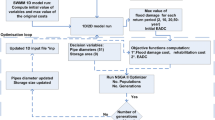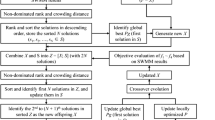Abstract
This study proposes a solution to prevent urban waterlogging, a challenging environmental issue, by integrating waterlogging prediction and drainage optimization schemes based on cellular automaton and multi-objective optimization theories. An urban waterlogging model for uncertain flow was constructed considering urban surface fragmentation and space complexity. For dynamic simulation, outputs of water depth and flooded areas were projected with inputs of rainfall, soil infiltration, plant interception, gully discharge, and outflow to its neighbors in each cell at any moment. Using a multi-objective optimization approach, the drainage decision model for optimal solutions calculated the maximal amount of water for pumping from flooded zones to candidate reservoirs with minimal energy cost. This integrated approach was successfully applied to the DongHaoChong catchment, an 11 km2 watershed in Guangzhou, southern China and validated by comparing the simulated flood areas with flooded points from two historical rainstorms (August 15, 2013 and June 23, 2014). The RMSE of the maximum waterlogging depth were 26.89 and 78.48 mm, respectively. Therefore, the proposed model was reliable and capable of simulating uncertain flow at any position and moment with minimal data input and parameters in an urban environment. Water-logged area and depth could be predicted based on the given rainfall assuming 1-, 10-, 50-, and 100-year storm data in the study area, and optimal drainage solutions could be obtained and verified. The proposed urban waterlogging prediction and drainage emergency models could optimize decision-making to improve emergency plans and reduce losses due to urban waterlogging.







Similar content being viewed by others
References
Bach PM, Rauch W, Mikkelsen PS, McCarthy DT, Deletic A (2014) A critical review of integrated urban water modelling—Urban drainage and beyond. Environ Modell Softw 54:88–107. https://doi.org/10.1016/j.envsoft.2013.12.018
Burrough PA, McDonnell RA (1998) Principles of geographical information systems. Oxford University Press, Oxford
Cirbus J, Podhoranyi M (2013) Cellular automata for the flow simulations on the earth surface, optimization computation process. Appl Math Inf Sci 7:2149–2158. https://doi.org/10.12785/amis/070605
Deb K (2001) Multi-objective optimization using evolutionary algorithms. John Wiley & Sons, Chichester
Dong Z, Lu J (2008) Numerical simulation of urban waterlogging disaster due to Plum storm. In: Advances in Water Resources and Hydraulic Engineering. Springer, Berlin, Heidelberg. https://doi.org/10.1007/978-3-540-89465-0_51
Elliot AH, Trowsdale SA (2007) A review of models for low impact urban stormwater drainage. Environ Modell Softw 22:394–405. https://doi.org/10.1016/j.envsoft.2005.12.005
Ellis JB, Deutsch JC, Mouchel JM, Scholes L, Revitt MD (2004) Multicriteria decision approaches to support sustainable drainage options for the treatment of highway and urban runoff. Sci Total Environ 334–335:251–260. https://doi.org/10.1016/j.scitotenv.2004.04.066
Fu-ping TANG, Man-chun LI, Fen QIN (2010) Distributed rainfall-runoff simulating based on cellular automata for small watersheds. Adv Water Sci 21(2):173–178
Gao T (2006) Analysis on design of urban road gully. China Water Waste Water 22:55–58
García Díaz RG (2005) Analysis of Manning coefficient for small-depth flows on vegetated beds. Hydrol Process 19:3221–3233. https://doi.org/10.1002/hyp.5820
García-Palomares JC, Gutiérrez J, Latorre M (2012) Optimizing the location of stations in bike-sharing programs: a GIS approach. Appl Geogr 35:235–246. https://doi.org/10.1016/J.APGEOG.2012.07.002
Gu L, Gu N (2014) Urban waterlogging and stormwater management. Appl Mech Mater 587–589:554–557. https://doi.org/10.4028/www.scientific.net/AMM.587-589.554
Guangzhou Water Authority (2011) Central urban rainstorm formula and calculation chart in guangzhou city. Guangzhou, pp 3–14
Hughes JD, Langevin CD, White JT (2014) MODFLOW-based coupled surface water routing and groundwater-flow simulation. Groundwater 53:452–463. https://doi.org/10.1111/gwat.12216
Labadie JW, Zheng F, Wan Y (2012) Optimal integrated operation of reservoir-assisted stormwater treatment areas for estuarine habitat restoration. Environ Modell Softw 38:271–282. https://doi.org/10.1016/j.envsoft.2012.07.005
Liu N, Huang B, Pan X (2005) Using the ant algorithm to derive Pareto fronts for multi-objective siting of emergency service facilities. Transp Res Rec 1935:120–129. https://doi.org/10.1177/0361198105193500114
Liu L, Liu Y, Wang X, Yu D, Liu K, Huang H, Hu G (2015) Developing an effective 2-D urban flood inundation model for city emergency management based on cellular automata. Nat Hazards Earth Syst Sci 15:381–391. https://doi.org/10.5194/nhess-15-381-2015
Ma T, Zhou CH, Cai QG (2009) Modeling of hillslope runoff and soil erosion at rainfall events using cellular automata approach. Pedosphere 19:711–718. https://doi.org/10.1016/S1002-0160(09)60166-1
Marlow DR, Moglia M, Cook S, Beale DJ (2013) Towards sustainable urban water management: a critical reassessment. Water Res 47:7150–7161. https://doi.org/10.1016/j.watres.2013.07.046
MathWorks (2012) Optimization toolbox of MATLAB. MathWorks Inc., Natick, Massachusetts. USA, pp 01760
Ostad-Ali-Askari K (2022) Developing an optimal design model of furrow irrigation based on the minimum cost and maximum irrigation efficiency. Appl Water Sci 12:144. https://doi.org/10.1007/s13201-022-01646-y
Ostad-Ali-Askari K, Shayannejad M, Eslamian S, Navabpour B (2018) Comparison of solutions of Saint-Venant equations by characteristics and finite difference methods for unsteady flow analysis in open channel. Int J Hydrol Sci Technol 8:229–243. https://doi.org/10.1504/IJHST.2018.093569
Park CH, Joo JG, Kim JH (2012) Integrated washland optimization model for flood mitigation using multi-objective genetic algorithm. J Hydro-Environ Res 6:119–126. https://doi.org/10.1016/j.jher.2012.01.004
Parsons JA, Fonstad MA (2007) A cellular automata model of surface water flow. Hydrol Process 21:2189–2195. https://doi.org/10.1002/hyp.6587
Penn R, Friedler E, Ostfeld A (2013) Multi-objective evolutionary optimization for greywater reuse in municipal sewer systems. Water Res 47:5911–5920. https://doi.org/10.1016/j.watres.2013.07.012
Quan RS, Liu M, Lu M, Zhang L, Wang J, Xu S (2010) Waterlogging risk assessment based on land use/cover change: a case study in Pudong New Area, Shanghai. Environ Earth Sci 61:1113–1121. https://doi.org/10.1007/s12665-009-0431-8
Ressano-Garcia A (2014) Urban stormwater management and waterlogging disaster prevention. Asia development bank https://www.adb.org/sites/default/files/project-document/80443/45512-001-tcr.pdf. Accessed 20 July 2022.
Samanlioglu F (2013) A multi-objective mathematical model for the industrial hazardous waste location-routing problem. Eur J Oper Res 226:332–340. https://doi.org/10.1016/j.ejor.2012.11.019
Schaffranek RW (2004) Simulation of surface-water integrated flow and transport in two dimensions: SWIFT2D User’s manual. Geological Survey (U.S.). https://doi.org/10.3133/tm6B1
Shayannejad M, Ghobadi M, Ostad-Ali-Askari K (2022) Modeling of surface flow and infiltration during surface irrigation advance based on numerical solution of saint-venant equations using Preissmann’s scheme. Pure Appl Geophys 179:1103–1113. https://doi.org/10.1007/s00024-022-02962-9
Spitz FJ (2007) Simulation of surface water conditions in the Nontidal Passaic river basin. New Jersey. https://doi.org/10.3133/sir20075052
Engineering Toolbox (2015) Water—dynamic and kinematic viscosity. http://www.engineeringtoolbox.com/water-dynamic-kinematic-viscosity-d_596.html?msclkid=7553ebffc70e11ec8243fe39d743f670. Accessed 30 June 2022
Valipour M (2014) Drainage, waterlogging, and salinity. Arch Agron Soil Sci 60:1625–1640. https://doi.org/10.1080/03650340.2014.905676
Wang FCO, Saavedra Valeriano OC, Sun X (2013) Near real-time optimization of multi-reservoir during flood season in the Fengman basin of China. Water Resour Manage 27:4315–4335. https://doi.org/10.1007/s11269-013-0410-4
Woodward M, Kapelan Z, Gouldby B (2014) Adaptive flood risk management under climate change uncertainty using real options and optimization. Risk Anal 34:75–92. https://doi.org/10.1111/risa.12088
Xiao N, Bennett DA, Armstrong MP (2007) Interactive evolutionary approaches to multiobjective spatial decision making: a synthetic review. Comput Environ Urban Syst 31:232–252. https://doi.org/10.1016/j.compenvurbsys.2006.08.001
Acknowledgements
This work was supported by the Key R&D Program of Guangzhou Sci-Tech Project (Grant number 202103050001).
Funding
This work was supported by the Key R&D Program of Guangzhou Sci-Tech Project (Grant number 202103050001).
Author information
Authors and Affiliations
Contributions
Conceptualization and funding, SC; methodology and formal analysis, SB; software and validation, ZL and BC; writing—original draft preparation, ZL; writing—review and editing, SB and SC; visualization, BC All authors read and approved the final manuscript.
Corresponding author
Ethics declarations
Conflict of interests
The authors have no relevant financial or non-financial interests to disclose.
Additional information
Publisher's Note
Springer Nature remains neutral with regard to jurisdictional claims in published maps and institutional affiliations.
Rights and permissions
Springer Nature or its licensor holds exclusive rights to this article under a publishing agreement with the author(s) or other rightsholder(s); author self-archiving of the accepted manuscript version of this article is solely governed by the terms of such publishing agreement and applicable law.
About this article
Cite this article
Bao, S., Lai, Z., Chen, B. et al. Urban drainage decision model for storm emergency management based on multi-objective optimization. Stoch Environ Res Risk Assess 37, 813–829 (2023). https://doi.org/10.1007/s00477-022-02315-x
Accepted:
Published:
Issue Date:
DOI: https://doi.org/10.1007/s00477-022-02315-x




